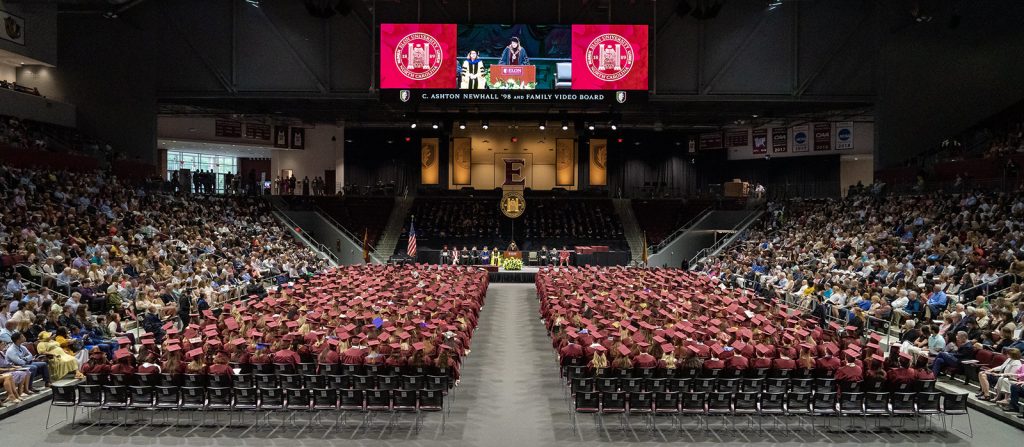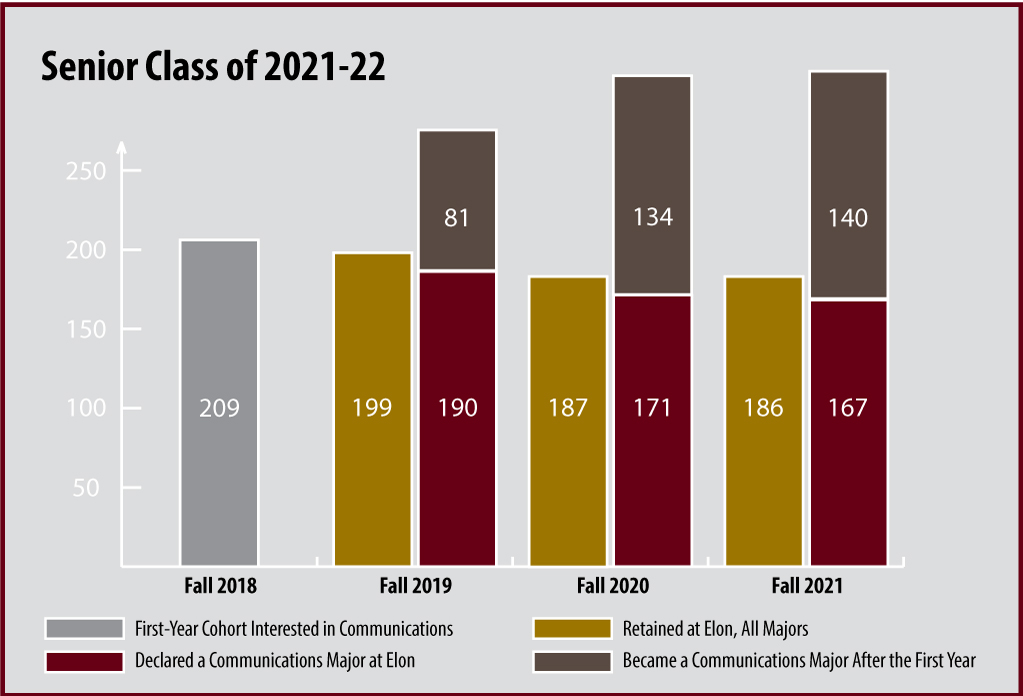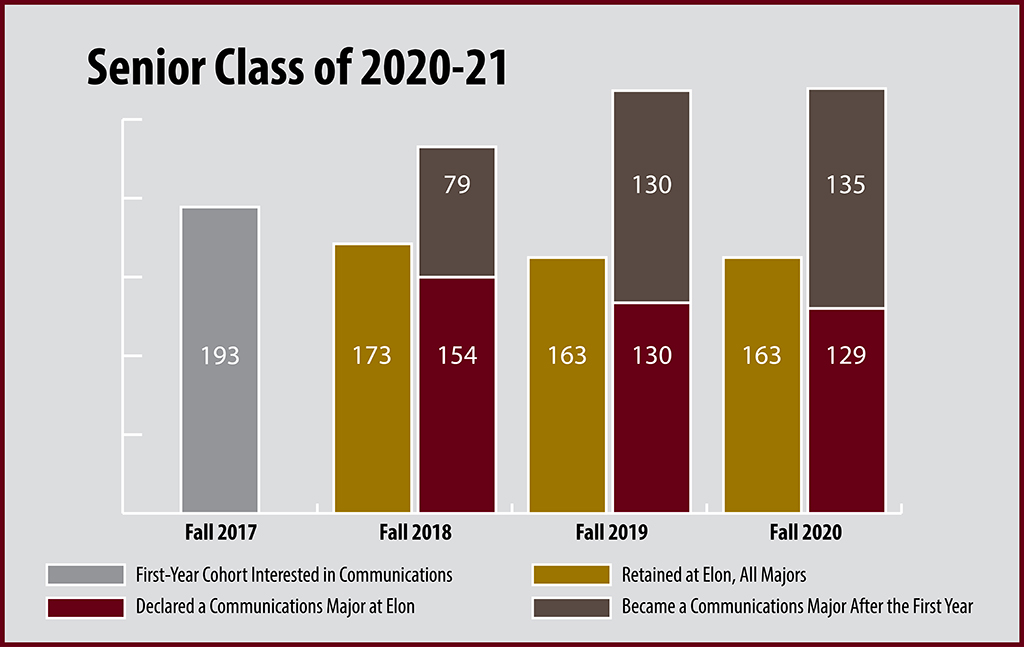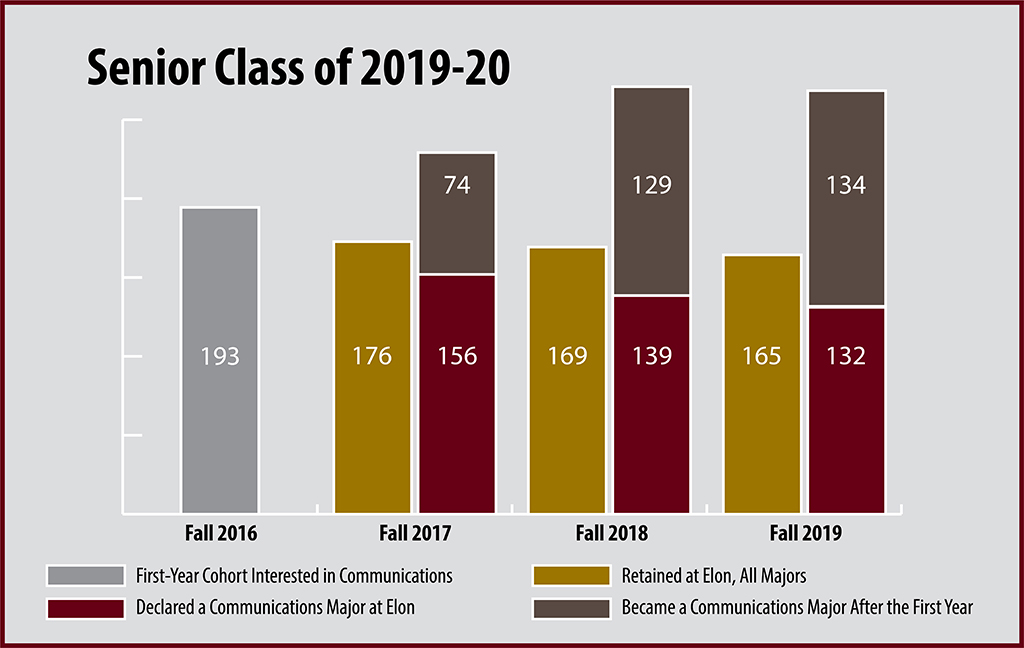- Home
- Academics
- Communications
- About the School
- Student Success Rates
Student Success Rates
 As a nationally accredited program, the School of Communications monitors four indicators of student success: enrollment, retention, graduation and employment.
As a nationally accredited program, the School of Communications monitors four indicators of student success: enrollment, retention, graduation and employment.
Enrollment
The School of Communications is home to about 20 percent of Elon’s student body. The school offers six undergraduate majors: Journalism, Strategic Communications, Cinema & Television Arts, Communication Design, Media Analytics, and Sport Management.
| Program | Fall 2023 | Fall 2022 | Fall 2021 | Fall 2020 |
|---|---|---|---|---|
| Undergraduate Programs |
||||
| Journalism | 152 | 172 | 167 | 178 |
| Strategic Communications | 415 | 430 | 474 | 496 |
| Cinema & Television Arts | 202 | 232 | 251 | 249 |
| Communication Design | 202 | 238 | 214 | 192 |
| Media Analytics | 86 | 108 | 117 | 104 |
| Sport Management | 235 | 200 | 200 | 189 |
| Undergraduate Total |
1,292 | 1,380 | 1,423 | 1,410 |
| Graduate Program |
||||
| M.A. in Interactive Media | 15 | 11 | 14 | 20 |
Retention
Retention refers to the number of students who return to school the following year. One method of determining retention in a major is based on the entering first-year class. Another method is based on the last declared major of all students at the university. This section provides data for both methods of calculation. The Accrediting Council on Education in Journalism and Mass Communications specifies that retention, graduation and employment data be provided for an accredited Communications program.
Retention and Growth Based on Entering First-Year Class
When students are admitted to Elon, they are free to enter the major of their choice, unlike some journalism and communications programs that have their own admission process or restrict students from declaring a major until the junior year. As a result, high school students who express an interest in Communications in their application process to Elon become the entering first-year cohort in Communications.
The chart below shows that 209 students expressed an interest in Communications when they applied and were admitted to Elon in fall 2018. Three years later, 186 of them (88.9%) had become seniors at Elon, with 167 (79.9%) as Communications majors. This means 19 seniors remained at Elon but had switched to other majors since their first year. Meanwhile, an additional 140 students from that first-year class became Communications majors after they began at Elon, resulting in 98 more students being Communications majors in the senior year (307) than in the entering first-year cohort.



Source: Elon’s Office of Institutional Research
These tables reflect full-time first-year students entering Elon. They do not include transfer students and count a student (for instance, those who double major) only once. The technical description is “unduplicated, first-time, full-time and first-year students enrolling at the university.” These tables and later ones do not include Sport Management, which is a separate department in the school and not part of the accreditation process.
Retention Based on Last Declared Major
A second method of determining retention in a major is based on the last declared major of all students at the university – both those who eventually graduate from Elon as well as those who leave the university with Communications as their last declared major. This method is used to describe enrollment and retention of Communications majors within the university over time and to calculate graduation rates, as shown in the next section.
The chart below shows retention of students in this cohort in comparison with students in the university overall. Of all first-time, full-time students who entered Elon in 2018, 331 students ultimately declared Communications as their last major in the university. Some entered Elon as first-year students having expressed an interest in Communications, some became Communications majors after starting at Elon, and others were Communications majors when they left the university.
Of the 331 last declared COM major students in entering cohort 2018, 318 (96.0%) returned to Elon the following year, 305 (92.1%) returned to the university by their junior year, and 303 (91.5%) remained and had declared a major in Communication by the end of the senior year.
Of those, 289 (87.3%) graduated in 4 years or less and 299 (90.3%) graduated in 5 years.
| Class of 2022 | Cohort | Sophomore Year | Junior Year | Senior Year |
|---|---|---|---|---|
| Communications Majors | 331 | 318 (96.0%) | 305 (92.1%) | 303 (91.5%) |
| All Elon Students | 1,698 | 1,548 (91.2%) | 1,466 (86.3%) | 1,435 (84.5%) |
| Class of 2021 | Cohort | Sophomore Year | Junior Year | Senior Year |
|---|---|---|---|---|
| Communications Majors | 298 | 275 (92.3%) | 259 (86.9%) | 261 (87.6%) |
| All Elon Students | 1,572 | 1,414 (89.9%) | 1,340 (85.2%) | 1,309 (83.3%) |
| Class of 2020 | Cohort | Sophomore Year | Junior Year | Senior Year |
|---|---|---|---|---|
| Communications Majors | 301 | 279 (93%) | 268 (89%) | 265 (88%) |
| All Elon Students | 1,553 | 1,386 (89.2%) | 1,324 (85.3%) | 1,286 (82.8%) |
Source: Elon’s Office of Institutional Research
University retention rates reflect full-time, first-year students in all majors who remain at Elon at the time of fall enrollment each year. Because students may change majors at any time, retention data for Communications majors are based on their declared major at the time of fall enrollment each year.
Graduation
A four-year graduation is the norm for Communications students at Elon.
In the graduating Class of 2022, 289 students graduated as Communications majors in four years. This is 87% of all Elon students whose last declared major was Communications.
| Graduating Class of 2022 | Cohort | 4-Year Graduation | 5-Year Graduation |
|---|---|---|---|
| Communications Majors | 331 | 289 (87.3%) | +10 = 299 (90.3%) |
| All Elon Students | 1,698 | 1,355 (79.8%) | N/A |
| Graduating Class of 2021 | Cohort | 4-Year Graduation | 5-Year Graduation |
|---|---|---|---|
| Communications Majors | 298 | 248 (83.7%) | +8 = 256 (86.5%) |
| All Elon Students | 1,572 | 1,229 (78.2%) | N/A |
| Graduating Class of 2020 | Cohort | 4-Year Graduation | 5-Year Graduation |
|---|---|---|---|
| Communications Majors | 301 | 258 (86%) | +3 = 261 (87%) |
| All Elon Students | 1,533 | 1,226 (78.9%) | N/A |
Employment
Each year the university conducts a survey of the most recent graduating class, nine months following graduation, to ascertain employment or graduate school status, type of employer, and salary. The report on the Class of 2022 was released by the Student Professional Development Center in spring 2023.
Employment and Graduate School Status, Nine Months After Graduation
| Graduating Class | 2022 | 2021 | 2020 |
|---|---|---|---|
| Communications Graduates Employed | 91.4% | 88.3% | 74.6% |
| Entering Graduate School | 7.2% | 3.9% | 6.4% |
A few graduates each year indicate they fit in both categories.
Employment by Organization Type
Communications graduates who are employed are asked each year to indicate the type of organization where they work.
| Organization Type | 2022 | 2021 | 2020 |
|---|---|---|---|
| Corporate For Profit | 80% | 93% | 79% |
| Not For Profit | 2% | 2% | 5% |
| Educational | 3% | 2% | 3% |
| Government | 3% | 0% | 2% |
| Entrepreneurial/Self-employed/Start-up | 3% | 3% | 10% |
2022 percentages were based on 254 employed graduates (of 278 total respondents) who reported their organization type; 2021 percentages were based on 226 responses; 2020 percentages were based on 200 responses.
Employment Related to Career Goals
In 2022, 97% of the employed Communications graduates who responded to this survey – and this specific question – said their work was related to their career goals.
Average Salaries
2022 Elon Communications graduates reported an average starting salary of $52,210.
— Last updated Aug. 28, 2023